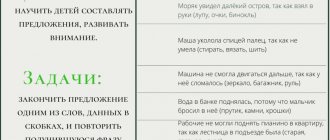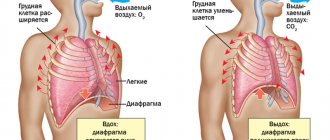Features of speech development in children of the sixth year of life
The speech of children, the development of which was given much attention by their parents and teachers, at this age stage is practically no different from the speech of adults. The successful mastery of literacy and writing in the first grade largely depends on the level at which it is located. If an older preschooler swaps sounds and syllables in oral speech, he will do this in the same way when writing and reading.
A meager vocabulary and undeveloped coherent speech will, after some time, prevent a child at school from retelling a text from a textbook or explaining how he got the answer to a problem. Moms and dads act recklessly, trying to make up for lost opportunities 3-4 months before entering first grade.
Intensive classes with a tutor may give a short-term advantage to a future first-grader, but this leap forward will lose its significance by the middle of the first school year if the child’s speech is undeveloped. Meanwhile, two years before school, a lot can still be done if you pay close attention to the speech development of children.
Lexicon
The active vocabulary of a five-year-old child has about 3 thousand words. Children already understand exactly what is meant by generalizing words - birds, wild and domestic animals, insects, trees. They master a huge range of concepts, and their knowledge extends not only to everyday objects within sight, but also to rather abstract things. They have accumulated impressive knowledge experience and can talk, for example, about astronautics and human relationships.
The quality of spoken words is also increasing, and annoying errors such as rearranged, added syllables and replaced, added and rearranged sounds appear less and less often in speech. They can now slip only when pronouncing polysyllabic unfamiliar words, for example, hairdresser, traffic controller, electricity, excavator, armored personnel carrier. Word games continue, as do rhyming and poetry writing.
Humorous literary works with permutations of words, as well as all kinds of verbal inversions and riddles, are very popular among children of this age:
Vanya was riding on a horse, leading a dog on a belt, and at that time the old woman was washing a ficus tree on the window.
Vanya was riding on a belt, leading a dog on a horse, and at that time the old woman was washing a ficus tree on the window.
A village was driving past a man. Suddenly the gate A barks from under the dog.
He grabbed the club and cut the ax. And the fence ran over our cat.
Grammar of the native language
If a five-year-old child asks about a familiar topic, he will easily answer it with a complete and detailed sentence. In normal speech, children use simple phrases, which become longer and more common by the age of six. Most of the words in the sentences are used and modified correctly, although there are also incorrect forms, for example, bear cubs and baby elephants instead of cubs and elephants, pencils instead of pencils, glasses instead of glasses.
Children play various word games with great pleasure:
- broken phone;
- what to call it differently (for selection of synonyms);
- say the opposite (search for antonyms);
- what is soft (sweet, tall, wooden);
- recognize the item by description;
- finish the sentence.
A child’s speech will not be grammatically correct if the adults in his immediate environment do not become an example of exemplary pronunciation for him. If they pronounce words incorrectly, place emphasis incorrectly, or abuse profanity, then the child will do the same.
Sound pronunciation
The speech apparatus of a child of the sixth year of life is fully formed and, if there are no deviations in its structure (short frenulum of the tongue, high palate, malocclusion), most sounds are pronounced by children correctly. The most common pronunciation deficiencies at this age are:
- distortion, replacement or absence of sound [l] (mayako - milk, yuka - tree, igoyka - needle, kovodets - well);
- replacement of the sound [r] with the sounds [l] or [th], its complete absence or distortion (yodka - boat, lyba - fish, baan - ram);
Children of this age can already independently notice such shortcomings in themselves and those around them. There is an opinion among preschool speech therapists that sounds that do not appear in the speech of children under five to five and a half years old are unlikely to appear on their own. If your pronunciation is defective or any sound is missing, you need to contact a specialist for examination and corrective classes.
Particular attention should be paid to the appearance of stuttering or speech hesitations. This is a very difficult speech defect, the correction of which can take several years. Stuttering occurs in children when thoughts do not keep up with speech, in children with a weak type of nervous system, with an overly strict family upbringing, and also as a result of a child’s elementary imitation of the speech of a stuttering adult.
Connected speech
It is impossible to give an accurate description of the level of development of coherent speech, which is common for the speech of 5-year-old children. Its range is very wide - from extensive, rich in epithets and the ability to use means of expressiveness (intonation, comparisons), in a child who can compose his own fairy tales, to inexpressive and monotonous in a preschooler, whose speech development no one has studied.
At this age, children can make up a story based on a picture, retell a work of art they have read, share their impressions of a trip, a trip to the theater, a museum, a cartoon they watched, or playing games with friends. They already consciously select the most vivid, precise, and meaningful words in order to more fully express their thoughts.
Unfortunately, some parents do not control the time their children spend on computer games. Even if we do not take into account their negative impact on the psyche, passion for gadgets negatively affects speech development. It’s sad to watch how a preschooler, having difficulty choosing answers to questions about the content of the work he read, a minute later, rushing and choking, enthusiastically talks about his successes in a computer game.
The active development of visual perception of computer reality in such cases occurs to the detriment of auditory speech perception and the ability to coherently express one’s thoughts. If the necessary measures are not taken in time, this can become a serious problem in child development in the future.
Diagnosis of speech development disorders in children 4–5 years old
There are several groups of speech disorders:
- Sound pronunciation defects. Articulates sounds incorrectly, replaces and omits them, swaps syllables in words;
- Lexical violations. Poor vocabulary, a 5-year-old child does not understand the meaning of words;
- Connectivity problems. Answers in monosyllables, there are no detailed answers, the narrative is illogical, the structure and grammatical order are broken;
- Melodic intonation defects. Does not control his voice, strength, timbre, pitch are impaired, the voice is inexpressive, monotonous, does not use interrogative and exclamation forms;
- Violation of tempo and rhythm. Speaks quickly or slowly, stammers, stops, speaks words syllable by syllable;
- Misunderstanding of spoken words. The most complex form of speech development disorder listed above.
If you suspect a delayed disorder in your child, do not waste time - show him to a neurologist and speech therapist. The sooner you start correctional work, the faster the child will “catch up” with the age norm for speech development. An excellent solution would be to enroll your child in a speech therapy group in kindergarten.
Norm of child speech development between the ages of 5 and 6 years
After we have examined the features of speech development of children 5–6 years old, let’s talk about existing standards. An older preschooler at this age makes almost no grammatical mistakes. Sometimes he may incorrectly place emphasis on unfamiliar words or use a noun in the wrong form. If adults point out mistakes made, then children in most cases do not repeat them. A child of the sixth year of life answers adults’ questions in detail, and does so clearly and clearly pronouncing the words.
He can compose a story based on a picture or a series of sequentially arranged pictures, come up with the beginning and ending of a story, come up with his own fairy tale or story, and retell works read to him. A five-year-old child can also describe objects, as well as find an object based on an adult’s description.
Children of this age can speak louder and quieter, faster and slower, in a whisper. Reciting poems and fairy tales by heart, five-year-old children do it very artistically, selecting the right intonation, making timely stops provided by the author. They can choose words that are similar or opposite in meaning. For example, sad means... gloomy, sad. They begin to actively use prefixed verbs. For example, this tap is open, but this one... is closed.
Children continue to classify words into groups: fir-tree, birch, aspen, pine - these are trees. Stork, swallow, rook, starling are birds. Cottage cheese, milk, cheese, kefir are dairy products. Children of the sixth year of life pronounce almost all sounds correctly, but there may be an absence or unclear pronunciation of the sounds [l] and [r].
Information for parents
Adults are role models and a source of knowledge for children. Therefore, it is important that parents take an active part in children's development and follow all recommendations of teachers.
Self-diagnosis of speech delay
The speech therapist conducts an examination in kindergarten and selects a group of children with whom he will carry out correction. But you shouldn’t wait for your child to sign up for lessons. Parents should be able to independently diagnose his speech development.
- The child is asked to describe the object being shown - a toy or other object.
- The adult describes the object, and the preschooler must name it.
- You need to check the expressiveness of speech: ask to speak sentences with different intonation and pitch of voice.
- The child is shown a picture and asked to describe what is shown in it. If he has any difficulties, the adult asks leading questions. During the story, you need to pay attention to the composition of the sentence, vocabulary and general expressiveness of speech.
- Parents should pay attention to the grammatical design of the sentence: agreement of words, use of conjunctions, particles, prepositions.
- During diagnosis, the formation of sound pronunciation is assessed.
Diagnostic conversation
Important! When inviting a child to complete tasks, an adult should give an example using his own example. For example, he asks a preschooler to name a word and first pronounces it himself.
In older preschool age, some mistakes are normal, because at six years old, not all children immediately absorb a large flow of information. But with the help of didactic games it is possible to cope with speech errors. Such exercises will also be useful for children with normal development.
How to develop speech in a 5 year old child
It is worth purchasing books by the following authors: Gerbova V.V., Kuznetsova E.V., Razumovskaya Yulia, Tikhonova I.A., Ushakova O.S. In their books, parents and teachers will be able to find lesson notes for speech development for 5-6 year olds that meet the requirements of the Federal State Educational Standard.
Specialists speak at parent meetings, where they explain in detail how to perform the exercises correctly and issue memos with detailed recommendations. The main goal of tasks in working with this age category is to develop coherent logical speech and form a grammatical structure.
The following exercises should be included in the file cabinet:
- selection of synonyms and antonyms;
- classification of objects according to one criterion;
- guessing words from descriptions;
- Declension of words by numbers and cases;
- making sentences from words;
- explanation of the meaning of proverbs and sayings;
- memorizing poems;
- performing articulatory gymnastics.
Speech development lesson
Important! When retelling a fairy tale or poem, pay attention to the expressiveness of speech and the clarity of pronunciation of sounds.
Setting the T sound
Talking about the world around you while walking has a beneficial effect on speech development; conversation with the child about how his day went and other topics of interest to him.
Educational online games are popular: in this case, adults do not need to prepare visual material and think through the exercise. But you need to ensure that the time spent at the computer does not exceed 10 minutes. It is better to alternate information technologies and oral exercises.
Symptoms of speech delay at 5 years
The first thing that parents who suspect that their child has problems with speech development needs to pay attention to is how understandable it is. Signs of undeveloped speech:
- strangers cannot always understand him;
- he speaks indistinctly;
- due to the fact that the speech is unintelligible, it is difficult to determine how literate it is and what grammatical categories he can use. For example, the number and gender of nouns, cases, number and person of verbs;
- the vocabulary is very small, even to a non-specialist it is noticeable that he lags behind his peers;
- phrases used in speech are short and incomplete, consisting of nouns and verbs;
- a large number of sounds are pronounced incorrectly or not pronounced at all.
If your child has at least one of these signs, it is safe to say that there is a speech delay.
Norm of speech development for children 4–5 years old
- Vocabulary – 2500 – 3000 words;
- Invents new words, rhymes;
- Adjectives, complex prepositions, and personal pronouns appear in the vocabulary;
- Periodically groups objects into categories (dishes, fruits, animals);
- Pronounces sounds more clearly and correctly;
- Can say several grammatically formed phrases.
The speech development of children aged 4–5 years is characterized by a sharp leap forward: they willingly talk, rush to speak out, which leads to errors in the logical construction of phrases, sound pronunciation, verb agreement, gender and number.
Self-diagnosis of speech delay
Parents can independently determine whether everything is okay with their children’s speech at 5 years old. To test your vocabulary, you can offer the following tasks:
- ask what this or that person is doing, how an object operates. For example, “What does a ship do?” (floats). “What is grandpa doing?” (digs a garden bed);
- ask to name opposite actions, for example, “sat down - stood up, opened - closed” or opposite signs, for example, “light - heavy, soft - hard”;
- suggest naming the baby animals, for example, “Who is the goat’s baby? Kid. Who's with the bear? Little bear. Who's at the cow? Calf. Who's with the horse? Foal”, etc.;
- check whether he knows the basic colors and shades, shapes of objects (triangular, round, square, oval, rectangular, polygonal);
- check if he can describe the object, for example, “What kind of chair? Soft, wooden, brown, with metal legs”;
- offer to get an object that is under the box, on the box, above the box, under the box, in front of the box, behind the box, in the box, between the boxes to determine the correct use of prepositions.
- form the plural form of a word, for example “This is a leg, and these are ... legs. This is a window, and these are... windows. This is a sparrow, and these are... sparrows";
- decline the noun: “What is this? Book. No what? Books. What was removed? A book. Where should I put my notebook? To the book. How did I cover the notebook? A book. What are we talking about? About the book";
- change the word by using it in a different way: “The son came to the park. How can you say this about your daughter? My daughter came to the park.” Place pictures in front of the child (yellow pear, yellow chicken, yellow sun, yellow beads) and ask them to name them.
Developing speech:
To check the construction of phrases, you need to invite the child to complete the sentence, using a plot picture: “A girl... watering flowers,” where mom or dad say only the first word. Next, you can ask leading questions to make the phrase more complete: “What is it watering with?” Where does it water? Why is it watering?
Checking whether the children’s word structure is suffering, they are asked to repeat complex words such as yogurt, academy, machine operator, skladchina, ceiling, pharmacist. Have your child repeat the word several times in a row to check if he is switching syllables, missing or replacing syllables and letters in syllables.
Speech development games at home
We offer a set of exercises. They are held in the form of a game:
- Days of the week. We name the days of the week, clap our hands - one clap per syllable. Then the parent simply claps, and the children guess the day of the week;
- Let's listen to the words. An adult chooses a topic, for example “Farm”, and 3 words on this topic (cow, carrot, field). Then he makes up a story with these words. The task is to jump every time an adult says one of three words;
- Let's rhyme. An adult chooses any word and comes up with rhymes for it. Then he describes him without naming him. For example, “bicycle” is “what is sent to grandparents in a letter” (“hello”). Preschoolers must guess it;
- If I... The adult comes up with phrases that begin with “If I...”, and the children must complete them. “If I go to bed in my clothes”, “If I don’t eat porridge”, “If I suddenly become big”;
- Apple relay. You will need apples with matches. Matches are stuck into the fruit and given to the baby. He must take out a match, describing the apple: red, plump, round, ripe;
- Part and whole. To play you need a ball. The adult throws it to the baby and names a part of some object (fender, screen, steering wheel). The preschooler must immediately say which thing the part belongs to and throw the ball back;
- Finish the word. You will need a ball. The adult throws it to the child and says the initial syllable of any word. The preschooler’s task is to finish the word by throwing the ball back;
- Opposites. We study antonyms. The parent says the word (sweet, big), and the child says the opposite meaning (sour, small). It's even more interesting to play with the ball;
- A hundred questions. Dad or mom takes several items that are well known to the child. For example, a book, a fork, a banana, a toy. You will also need 50 chips. The game consists of the child asking questions about each thing. They can be the most incredible. For each question the kid gets a chip. You can play alone, but it’s more interesting in a group of several people;
- Nonsense. The parent talks about different consoles - non-, mini-, maxi-, anti-, archi-. You need to make sure that the child understands and remembers everything. Then he names any word, and the preschooler must add a prefix from those listed and talk about what has received a new name. For example, an anti-dog: what it is like, where it lives, what it likes, what it looks like. If several children are playing, the adult “distributes” one console to each one, and then says a word - each participant adds his own console to it.
Both one child and several of his friends (up to 6 people) can take part in the games. The more people, the merrier.
Prevention of speech delay
The formation of a senior preschooler’s perfect speech is influenced by his living conditions, the characteristics of his parents’ upbringing style, and, most importantly, the efforts of caring adults. To avoid finding yourself on the threshold of school in a situation where a child has discovered numerous speech disorders and there is no time to correct them, you need to take care in advance of the harmonious development of the child’s speech.
To solve this problem, close communication between children and adults is of great importance. Walking together, doing creative work, looking at book illustrations with a parallel discussion of what they saw and felt. This work will give a powerful impetus to the development of the baby’s speech. It is very valuable to learn and use such rich material as counting rhymes, tongue twisters, poems, riddles, sayings, nursery rhymes, and proverbs. All words that children do not understand need to be explained and ensure that they are used correctly.
Reading children's literature should be accompanied by a conversation about the actions of the characters and an explanation of incomprehensible words. When memorizing poetic works, it is very useful to replenish a child’s vocabulary by drawing his attention to the figures of speech used by the author. “A dark forest that covered itself with a wonderful hat...” “What hat did the poet write about?” “And fell asleep under her quietly, soundly...” “Do you think the forest can fall asleep?” “How do you understand the word restlessly?”
In order to fully prepare for schooling, a child of five to six years old must be able to coherently express his thoughts and construct logical, complete statements. It is important to correct deficiencies in sound pronunciation in a timely manner, to teach children to use their voice and means of expression. If children receive a lot of positive information from the outside world and from fiction that they can discuss with adults, this greatly stimulates children's speech development.
Why are speech games needed?
Speech therapy game is the optimal method for developing speech skills. All children love to play. And if you combine business with pleasure, you will be able to form:
- rhythm and clarity of speech;
- ability to place accents;
- large vocabulary;
- coherent speech (in the form of monologue and dialogue);
- correct articulation;
- skills in choosing the desired grammatical form of a word;
- basis for learning to read and write.
Kids like games much more than tedious exercises for finding mistakes and repeating difficult to pronounce phonemes. Motivation for such activities is much higher, and therefore the game form of learning is the most effective.
When playing with a child, a parent must give him the opportunity to fully express his feelings and experiences. Otherwise, the baby’s interest in communication and speech activity decreases. Don't put pressure on children. If you can’t find a word, you can replace it with facial expressions and gestures.
Possible causes of speech disorders
If a child speaks poorly at the age of 6, the main causes of speech impairment are diagnosed: dyslalia, motor alalia, sensory alalia and dysarthria.
Only a qualified specialist - a pediatric neurologist, psychoneurologist, speech therapist - can make a diagnosis based on the results of the examination. They will also offer recommendations on medication and pedagogical correction of speech defects.
Dislalia
Dyslalia means a violation of sound pronunciation, which is based on a defect in the anatomy of the organs of articulation, reversible disorders of the cerebral cortex (minimal cerebral dysfunction), and social neglect.
Possible defects of the articulation organs:
- short frenulum of the tongue;
- thick lips;
- massive tongue;
- too narrow language;
- high “Gothic” palate;
- low and wide palate;
- malocclusion;
- distances between teeth;
- sparse or small teeth.
Dyslalia at the age of 6 can be diagnosed in children growing up in a bilingual family, imitating the incorrect speech of loved ones, in socially disadvantaged families, as well as in children living in a situation of overprotection.
Dyslalia refers to the replacement, omission or distortion of sound. In order to eliminate dyslalia in six-year-old children, corrective classes with a speech therapist are needed, and possibly correction of the bite by an orthodontist.
Motor alalia
If a 6-year-old child has a very small vocabulary, his first words appeared late, he rearranges and shortens words and syllables, perhaps he has motor alalia.
This is a disease in which children understand the speech of those around them, but cannot construct their own full-fledged statement. Its cause is a violation of the maturation of the speech zones of the brain, their damage as a result of birth trauma, or pathologies of intrauterine development.
Manifestations of motor alalia at 6 years of age:
- distortion of words, replacement with others that are similar in meaning;
- violation of word agreement by gender, case and number;
- slower selection of words in statements;
- repetition of the same words and sound combinations.
There are also deviations from the norm in the movements and behavior of such children; they lack dexterity and have poorly developed fine motor skills. Attention, memory, and intellectual activity suffer, and the desire to understand the world is reduced.
See more about motor alalia - causes, symptoms, diagnosis, treatment and prognosis.
Sensory alalia
Manifestations of sensory alalia are similar to those of motor alalia. The main difference in the structure of the defect is that children do not understand speech addressed to them and therefore have difficulty forming their own statements. Their speech develops late; it is replete with irregular words that do not change according to gender, case and number. Children are slow and inactive, and have severe motor impairment.
Diagnosing sensory alalia at the age of 6 is not easy - the baby may not understand speech addressed to him at all, and may not even respond to his own name.
Manifestations of this defect are sometimes wrongly confused with autism, mental retardation, and mental retardation. In general, six-year-old children with sensory alalia are active in terms of speech, but may become irritated and show negativity due to the fact that they cannot fully communicate with others.
Dysarthria
Most often, 6-year-old children who speak poorly suffer from dysarthria. This speech disorder is associated with damage to parts of the brain that occurs during intrauterine development, childbirth, after diseases of the central nervous system, as a result of chromosomal abnormalities.
The speech of a child with erased dysarthria is difficult to understand for others, it is unclear, and sound pronunciation is blurred. The voice is quiet, but can also be sharp, the pace of speech is accelerated or slowed down. Such children do not like to chew solid food, find it difficult to cut with scissors, draw, perform movements to music, or maintain balance.









